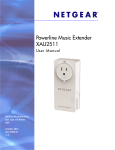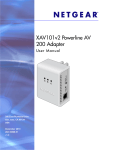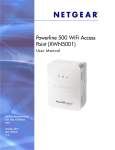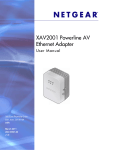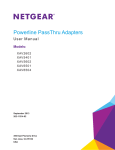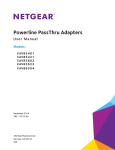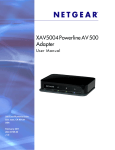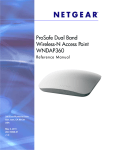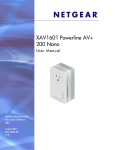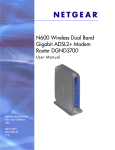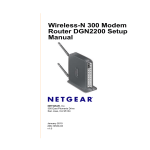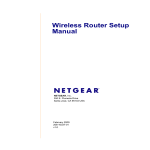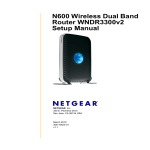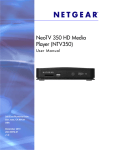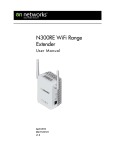Download Powerline Edition (XAVN2001) User Manual
Transcript
Universal WiFi Extender Powerline Edition (XAVN2001) User M anua l 350 East Plumeria Drive San Jose, CA 95134 USA January 2013 202-10998-01 Universal WiFi Extender - Powerline Edition (XAVN2001) Support Thank you for selecting NETGEAR products. After installing your device, locate the serial number on the label of your product and use it to register your product at https://my.netgear.com. You must register your product before you can use NETGEAR telephone support. NETGEAR recommends registering your product through the NETGEAR website. For product updates and web support, visit http://support.netgear.com. Phone (US & Canada only): 1-888-NETGEAR. Phone (Other Countries): Check the list of phone numbers at http://support.netgear.com/general/contact/default.aspx. Trademarks NETGEAR, the NETGEAR logo, and Connect with Innovation are trademarks and/or registered trademarks of NETGEAR, Inc. and/or its subsidiaries in the United States and/or other countries. Information is subject to change without notice. © NETGEAR, Inc. All rights reserved. 2 Contents Chapter 1 Getting Started Hardware Features. . . . . . . . . . . . . . . . . . . . . . . . . . . . . . . . . . . . . . . . . . . . 6 LED and Feature Descriptions . . . . . . . . . . . . . . . . . . . . . . . . . . . . . . . . . 7 How the WiFi Extender Fits into Your Network . . . . . . . . . . . . . . . . . . . . . . 8 Set Up the Powerline Network . . . . . . . . . . . . . . . . . . . . . . . . . . . . . . . . . . 10 Set Up a New Powerline Network . . . . . . . . . . . . . . . . . . . . . . . . . . . . . 10 Add the WiFi Extender to an Existing Powerline Network . . . . . . . . . . . 11 Set Up the WiFi Extender Wireless Network . . . . . . . . . . . . . . . . . . . . . . . 12 Method A: Use NETGEAR genie for Wireless Setup . . . . . . . . . . . . . . . 12 Method B: Use WPS for Wireless Setup . . . . . . . . . . . . . . . . . . . . . . . . 15 Join the WiFi Extender Wireless Network . . . . . . . . . . . . . . . . . . . . . . . . . 16 Method A: Join the Wireless Network Manually . . . . . . . . . . . . . . . . . . . 16 Method B: Join the Wireless Network Using WPS . . . . . . . . . . . . . . . . . 16 Powerline Network Security . . . . . . . . . . . . . . . . . . . . . . . . . . . . . . . . . . . . 17 Use the Security Button to Set the Encryption Key . . . . . . . . . . . . . . . . . . 17 Chapter 2 Using NETGEAR genie Install NETGEAR genie . . . . . . . . . . . . . . . . . . . . . . . . . . . . . . . . . . . . . . . 21 The Powerline Utility Screen . . . . . . . . . . . . . . . . . . . . . . . . . . . . . . . . . . . 22 Security Icon. . . . . . . . . . . . . . . . . . . . . . . . . . . . . . . . . . . . . . . . . . . . . . 23 View the Link Rate between Powerline Devices . . . . . . . . . . . . . . . . . . . . 24 Change the Name of a Powerline Device. . . . . . . . . . . . . . . . . . . . . . . . . . 25 Turn LEDs Off or On. . . . . . . . . . . . . . . . . . . . . . . . . . . . . . . . . . . . . . . . . . 26 Set the Powerline Encryption Key . . . . . . . . . . . . . . . . . . . . . . . . . . . . . . . 26 Reset a Device to Factory Default Settings . . . . . . . . . . . . . . . . . . . . . . . . 28 Add a Device to the Powerline Network . . . . . . . . . . . . . . . . . . . . . . . . . . . 29 Change the Wireless Settings . . . . . . . . . . . . . . . . . . . . . . . . . . . . . . . . . . 30 Access NETGEAR Web genie . . . . . . . . . . . . . . . . . . . . . . . . . . . . . . . . . . 31 Configure Advanced Wireless Settings . . . . . . . . . . . . . . . . . . . . . . . . . . . 33 Update the Firmware . . . . . . . . . . . . . . . . . . . . . . . . . . . . . . . . . . . . . . . . . 34 Chapter 3 Troubleshooting Basic Functioning . . . . . . . . . . . . . . . . . . . . . . . . . . . . . . . . . . . . . . . . . . . . 36 Troubleshooting Tips . . . . . . . . . . . . . . . . . . . . . . . . . . . . . . . . . . . . . . . . . 36 LEDs. . . . . . . . . . . . . . . . . . . . . . . . . . . . . . . . . . . . . . . . . . . . . . . . . . . . 36 If You Do Not See All Your Devices with the NETGEAR genie . . . . . . . . . 38 If You Do Not See the Powerline Icon on Your Network Map . . . . . . . . . . 38 Symantec Endpoint Protection . . . . . . . . . . . . . . . . . . . . . . . . . . . . . . . . 38 Appendix A Supplemental Information Technical Specifications . . . . . . . . . . . . . . . . . . . . . . . . . . . . . . . . . . . . . . . 43 3 Universal WiFi Extender - Powerline Edition (XAVN2001) Safety Information . . . . . . . . . . . . . . . . . . . . . . . . . . . . . . . . . . . . . . . . . . . 44 Appendix B Notification of Compliance Index 4 1. 1 Getting Started This chapter describes your Universal WiFi Extender (XAVN2001) and how your WiFi extender fits into a home network. It also explains the security features and how to secure your Powerline network with a private encryption key. This chapter includes: • Hardware Features • How the WiFi Extender Fits into Your Network • Set Up the Powerline Network • Set Up the WiFi Extender Wireless Network • Join the WiFi Extender Wireless Network • Powerline Network Security • Use the Security Button to Set the Encryption Key For more information about the topics covered in this manual, visit the NETGEAR support website at http://support.netgear.com. 5 Universal WiFi Extender - Powerline Edition (XAVN2001) Hardware Features The package includes a Universal WiFi Extender (XAVN2001) and an Ethernet cable. Ethernet cable Universal WiFi Extender – Powerline Edition (XAVN2001) Figure 1. Package contents Power LED Powerline LED Wireless LED Security button Ethernet port Factory Reset button On/Off switch Ethernet LED Figure 2. Universal WiFi Extender - Powerline Edition (XAVN2001) Getting Started 6 Universal WiFi Extender - Powerline Edition (XAVN2001) LED and Feature Descriptions Table 1. LED descriptions Item Description Power LED • Solid green. The electrical power is on. • Blinking green. The device is in the process of setting up security. • Amber. Power saving mode. If the Ethernet port is inactive for more than 10 minutes, the device enters power saving mode. Power saving mode is disabled by default. • Off. There is no electrical power or the LEDs have been turned off using NETGEAR genie. Powerline LED • Solid. The device is connected to a Powerline network. • Off. The device has not found any other compatible Powerline devices using the same encryption key. The Pick A Plug feature lets you pick the electrical outlet with the fastest link rate, indicated by the color of the LED: Green. Link rate > 80 Mbps (Fast) Amber. Link rate > 50 and < 80 Mbps (Medium) Red. Link rate < 50 Mbps (Slow) Wireless LED • Solid green. The wireless radio is on. • Off. The wireless radio is off. Ethernet LED • Solid green. The Powerline device is connected through the Ethernet port to a powered-on Ethernet device. • Off. There is no Ethernet connection. Buttons • Factory Reset. Use the Factory Reset button to return your Powerline device to its factory default settings. Press the Factory Reset button for 2 seconds, and then release it. • Security. The Security button has the following three functions: • - Once the Powerline devices are active, you can use the Security button to secure your Powerline network with a private encryption key. See Use the Security Button to Set the Encryption Key on page 17. - You can use the Security button to automatically create a wireless network on the WiFi extender that has the same wireless settings as your wireless router or gateway. See Method B: Use WPS for Wireless Setup on page 15. - The Security button provides an easy way (WPS) for your wireless computer or device to join the WiFi extender wireless network. See Method B: Join the Wireless Network Using WPS on page 16. On/Off. Use the On/Off switch to turn the device on and off. Getting Started 7 Universal WiFi Extender - Powerline Edition (XAVN2001) Ethernet Port The WiFi extender uses an Ethernet port to convert a standard electrical wall outlet into a high-speed wired network connection. You can use the wired network connection to bring Internet connectivity to any device with an Ethernet port, such as a computer, game console, Blu-ray™ player, smart TV, HD set-top box, or network DVR. Product Label The product label is on the back of the device. The label shows unique details specific to your device, including the following information. • Model number • Powerline MAC address • Ethernet/wireless MAC address • Serial number • Device password • WPS security PIN • Default wireless network name (SSID) • Default network key (wireless network password) How the WiFi Extender Fits into Your Network You can use one or more WiFi extenders to extend wireless and wired Internet access throughout your home. A Powerline network consists of two or more compatible Powerline devices that communicate with each other using your electrical power lines. One of the Powerline devices is connected with an Ethernet cable to your router so that the Powerline network is linked to your local area network (LAN). Connecting one Powerline device to your router allows all the Powerline devices on the Powerline network to communicate with the router and use its Internet connection. If your home network includes a wireless router or gateway, you can use the WiFi extender to extend the coverage of your existing wireless network or to create a second wireless network. If you have a wired router or gateway, the WiFi extender can use your wired Internet connection to create a wireless network in your home. Getting Started 8 Universal WiFi Extender - Powerline Edition (XAVN2001) The following illustration shows a Powerline network with one Powerline device in Room 1, a second Powerline device in Room 2, and a WiFi extender (XAVN2001) in Room 3. Room 1 Room 2 Room 3 WiFi extender Powerline Reset Reset Powerline Figure 3. WiFi extender (XAVN2001) connected to a Powerline network and wireless network To form a Powerline network, you need at least two compatible Powerline devices (including the WiFi extender). For best performance, plan the location of your Powerline devices. • Use an electrical outlet that is not controlled by a wall switch to avoid accidentally turning off the power to the outlet. • Avoid plugging Powerline products into electrical outlets that are located near appliances that consume a lot of power, such as washers, dryers, or refrigerators. Interference from these appliances might prevent Powerline products from working correctly or reduce Powerline network performance. • Do not plug Powerline products into a power strip, extension cord, or surge protector. Connecting a Powerline product to one of these devices might prevent the product from working correctly or reduce Powerline network performance. Getting Started 9 Universal WiFi Extender - Powerline Edition (XAVN2001) Set Up the Powerline Network You can set up a new Powerline network that includes the WiFi extender or you can add the WiFi extender to an existing Powerline network. Set Up a New Powerline Network Different Powerline models can share the same Powerline network. All NETGEAR Powerline AV products are compatible. First Powerline device To set up a new Powerline network: 1. Make sure that your wired Ethernet connections are working. If you have an existing wireless network, make sure that it is connected to the Internet. Reset a. On a computer that is connected to your router or gateway using an Ethernet cable, open a web browser and navigate to a web page. b. On a computer or device that is connected to your wireless network, open a web browser and navigate to a web page. 2. Plug the first Powerline device (sold separately) into a wall outlet near your router or gateway. Then, connect the device to the LAN port on your router or gateway using an Ethernet cable. 3. Plug the WiFi extender into a wall outlet where you need wireless coverage. WiFi extender 4. (Optional) You can use the provided Ethernet cable to connect the WiFi extender to an Ethernet port on a computer, game console, Blu-ray player, or other peripheral device. The Powerline devices attempt to detect each other and form a Powerline network. 5. Wait for each Powerline device to be recognized by the Powerline network. This process could take as little as 5 seconds or up to 80 seconds. When the Power and Powerline LEDs stop blinking, the process is complete. If the Powerline LEDs are green or amber, the devices are successfully connected to the Powerline network. A red Powerline LED indicates a slow link rate. In this case, move the Powerline device to another electrical outlet with a faster connection. 6. Set up the WiFi extender wireless network as explained in Set Up the WiFi Extender Wireless Network on page 12. Getting Started 10 Universal WiFi Extender - Powerline Edition (XAVN2001) Add the WiFi Extender to an Existing Powerline Network If you have an existing Powerline network, make sure one of the Powerline devices is connected to your router or gateway so that the Powerline network is linked to your local area network (LAN). Your existing Powerline network must have two or more compatible Powerline devices that communicate with each other. To add the WiFi extender to an existing Powerline network: 1. If you used the Security buttons or NETGEAR genie to secure your Powerline network, press the Factory Reset button for 2 seconds on each Powerline device to return it to its factory default settings. This is the quickest way to allow your new WiFi extender to communicate with the other Powerline devices. 2. Plug the WiFi extender into a wall outlet where you need wireless coverage. WiFi extender 3. (Optional) You can use the provided Ethernet cable to connect the WiFi extender to an Ethernet port on a computer, game console, Blu-ray player, or other peripheral device. The Powerline devices attempt to detect each other and form a Powerline network. 4. Wait for each Powerline device to be recognized by the Powerline network. This process could take as little as 5 seconds or up to 80 seconds. When the Power and Powerline LEDs stop blinking, the process is complete. If the Powerline LEDs are green or amber, the devices are successfully connected to the Powerline network. A red Powerline LED indicates a slow link rate. In this case, move the Powerline device to another electrical outlet with a faster connection. 5. Set up the WiFi extender wireless network as explained in Set Up the WiFi Extender Wireless Network on page 12. Getting Started 11 Universal WiFi Extender - Powerline Edition (XAVN2001) Set Up the WiFi Extender Wireless Network You can use either NETGEAR genie or Wi-Fi Protected Setup (WPS) to setup the WiFi extender (XAVN2001) wireless network. • If your router does not have a WPS button or if you are not sure, use Method A. • If your router has a WPS button, use Method B. Method A: Use NETGEAR genie for Wireless Setup To use NETGEAR genie to manually configure the wireless settings of your WiFi extender: 1. On a computer that has Internet access, download and install NETGEAR genie. See Install NETGEAR genie on page 21. 2. Temporarily connect the computer to the Ethernet port on the WiFi extender using the provided Ethernet cable. 3. Launch NETGEAR genie in one of two ways: • Click the NETGEAR genie shortcut icon on your desktop. • Select Start > All Programs > NETGEAR genie. 4. Click Network Map or select it from the list of menu items on the left. Getting Started 12 Universal WiFi Extender - Powerline Edition (XAVN2001) 5. Click the Powerline icon on the Network Map screen. The Powerline Utility screen displays. 6. On the Powerline Utility screen, right-click the XAVN2001 icon. 7. On the pop-up menu that displays, select Wireless configuration. Getting Started 13 Universal WiFi Extender - Powerline Edition (XAVN2001) The following screen displays: 8. Enter the following wireless settings: • Wireless Network Name (SSID) • Wireless Security Type • Passphrase If you want to clone your existing wireless network, enter the same wireless settings that your router or gateway uses. If you want to create a new wireless network, enter new wireless settings. 9. Click Apply to save your changes. 10. When you are finished with the wireless settings, disconnect the Ethernet cable from the WiFi extender. Note: To configure advanced wireless settings, see Access NETGEAR Web genie on page 31. Getting Started 14 Universal WiFi Extender - Powerline Edition (XAVN2001) Method B: Use WPS for Wireless Setup If your wireless router or gateway has a WPS (Wi-Fi Protected Setup) button, you can use this method for wireless setup. The WPS button might be labeled WPS or it could look similar or . to To use the WPS button on your wireless router or gateway to clone your existing wireless network: 1. Press and hold the Security button on the WiFi extender for about 10 seconds, and then release it. The Wireless LED starts blinking. 2. Press the WPS button on the wireless router or gateway. When the Wireless LED stops blinking and lights solid green, the cloning is finalized. You now have two wireless networks with the same settings (SSID and password). When you are roaming in your house, your wireless device (laptop, tablet, or smartphone) switches from one network (router or gateway) to the other (WiFi extender), depending on the signal quality. Getting Started 15 Universal WiFi Extender - Powerline Edition (XAVN2001) Join the WiFi Extender Wireless Network You can connect your wireless devices (such as a laptop or game console) to your WiFi extender wireless network in one of two ways. • If your wireless computer or device does not have a WPS button or if you are not sure, use Method A. • If your wireless computer or device has a WPS button, use Method B. Method A: Join the Wireless Network Manually To join the wireless network manually: 1. On your wireless computer or device, launch the software that manages your wireless network connections. The software scans for all wireless networks in your area. 2. Look for the WiFi extender wireless network and select it. The default wireless network name (SSID) is printed on the product label. If you changed this setting, look for the network name that you used. 3. Enter the network key (wireless network password). The default network key is printed on the product label. If you changed this setting, enter the network key that you used. Method B: Join the Wireless Network Using WPS If your wireless computer or device has a WPS (Wi-Fi Protected Setup) button, you can use this method to join the WiFi extender wireless network. The WPS button might be labeled or . WPS or it could look similar to To join the wireless network using WPS: 1. Press the WPS button on your wireless computer or device. 2. Press and hold the Security button for about 2 seconds, and then release it. The Wireless LED starts blinking. When the Wireless LED stops blinking and lights solid green, the wireless device is securely connected to the WiFi extender. Getting Started 16 Universal WiFi Extender - Powerline Edition (XAVN2001) Powerline Network Security A Powerline network consists of two or more Powerline devices using the same network encryption key. Securing your network is crucial. By encrypting the information that you send over the Powerline network, you help to keep it secure from hackers. If you do not set up security on your network, anyone nearby with a Powerline network can potentially use his or her connection to gain access to your network and information that you send over the Internet. This concern is especially relevant in settings such as apartment buildings, office buildings, dorm rooms, and other more populated areas. You can use either the Security button on the Powerline device or NETGEAR genie to secure your Powerline network. • Use the Security button on the Powerline device to automatically generate a random private encryption key. See Use the Security Button to Set the Encryption Key on page 17. • Use NETGEAR genie to configure your Powerline network with a private encryption key that you specify. See Install NETGEAR genie on page 21. Use the Security Button to Set the Encryption Key Note: A Powerline device can generate a random private encryption key only once. If you want to generate a new random key, first reset the Powerline devices to their factory default settings. Either press the Factory Reset button for 2 seconds, then release it, or use the NETGEAR genie factory reset feature. (See Reset a Device to Factory Default Settings on page 28.) You can use the Security button to replace the default encryption key with a random private encryption key. The default encryption key is HomePlugAV. To set the encryption key: 1. Make sure that all of the Powerline devices that you want to configure are plugged in. Verify that the Power and Powerline LEDs on each device are lit solid green. Reset Getting Started 17 Universal WiFi Extender - Powerline Edition (XAVN2001) CAUTION: Do not press the Security button on the Powerline devices until the Power and Powerline LEDs on each Powerline device are lit solid green. Pressing the Security button too soon can temporarily disable Powerline communication. If Powerline communication is disabled, reset the Powerline device to its factory default settings. (Press the Factory Reset button for 2 seconds, then release it). 2. Press the Security button on the first Powerline device for 2 seconds. • The Power LED starts blinking after you release the button. • The Powerline device automatically creates a new, randomly generated encryption key that all other Powerline devices on the network will use. At this point, the Powerline devices cannot communicate with each other. 3. Within 2 minutes of pressing the Security button on the first Powerline device, press the Security button on the second Powerline device for 2 seconds. You must press both Security buttons within 2 minutes. • The Power LED starts blinking after you release the button. This process allows the second Powerline device to use the same private encryption key as the first device so that they can communicate. Reset • Reset When the Power LEDs stop blinking and the Powerline LEDs are lit solid green, the two devices can communicate over the Powerline network in a secure way. Getting Started 18 Universal WiFi Extender - Powerline Edition (XAVN2001) Note: This process works for only one pair of Powerline devices at a time. If you have more than two Powerline devices, repeat this process for each additional Powerline device to be configured. The devices retain security settings even if they are unplugged. Getting Started 19 2. 2 Using NETGEAR genie This chapter explains how to install NETGEAR genie and use it to manage your Powerline network. NETGEAR genie works with all Powerline devices. You can use NETGEAR genie to manage a local Powerline device that is connected to your computer with an Ethernet cable and also to manage other Powerline devices on the same network. This chapter includes: • Install NETGEAR genie • The Powerline Utility Screen • View the Link Rate between Powerline Devices • Change the Name of a Powerline Device • Turn LEDs Off or On • Set the Powerline Encryption Key • Reset a Device to Factory Default Settings • Add a Device to the Powerline Network • Change the Wireless Settings • Access NETGEAR Web genie • Configure Advanced Wireless Settings • Update the Firmware 20 Universal WiFi Extender - Powerline Edition (XAVN2001) Install NETGEAR genie NETGEAR genie allows you to set a private encryption key for your Powerline network and manage devices on your Powerline network. You can manage the Powerline network using any computer that is connected to your Powerline network, wirelessly or through an Ethernet cable. All devices on a Powerline network can be managed from one computer. Note: If you already have NETGEAR genie installed on your computer, you must reinstall the latest version to get support for Powerline products. NETGEAR genie is a free download available from the NETGEAR website. To install NETGEAR genie on your computer: 1. Launch an Internet browser and visit http://support.netgear.com. 2. Click the For Home tab. 3. In the search box, type xavn2001v2 and press Enter. 4. Select NETGEAR genie from the downloads list. 5. Click the Download button to download NETGEAR genie to your computer. 6. Run the file that you downloaded and follow the setup prompts to install NETGEAR genie. Click Finish to complete the setup. Using NETGEAR genie 21 Universal WiFi Extender - Powerline Edition (XAVN2001) The NETGEAR genie shortcut icon displays on your desktop. 7. Launch NETGEAR genie in one of two ways: • Click the NETGEAR genie shortcut icon on your desktop. • Select Start > All Programs > NETGEAR genie. The Powerline Utility Screen The Powerline Utility screen is where you view and manage your Powerline network. To navigate to the Powerline Utility screen: 1. On a computer that is connected to your Powerline network, launch NETGEAR genie. 2. From the NETGEAR genie Home screen, click Network Map on the dashboard or select it from the list of menu items on the left. Using NETGEAR genie 22 Universal WiFi Extender - Powerline Edition (XAVN2001) 3. On the Network Map screen, click the Powerline icon to view all the devices on your Powerline network. The Powerline Utility screen displays. • For management options, right-click the icon of the device that you want to manage. • If all devices are not shown, click the Refresh icon to update the screen. • Move your mouse over an icon of a device to view more information about the device. Powerline icon Security icon Refresh icon Device icon (XAVN2001) Device information Security Icon You can click the Security icon on the Powerline Utility screen to go to the Security screen. • If the Powerline devices are secured using the default encryption key, the unlocked Security icon displays. • If the Powerline devices are secured using a private encryption key, the locked Security icon displays. See Set the Powerline Encryption Key on page 26 for more information about how to set the encryption key for your Powerline devices. Using NETGEAR genie 23 Universal WiFi Extender - Powerline Edition (XAVN2001) View the Link Rate between Powerline Devices To view the link rate between your Powerline devices: On the Powerline Utility screen, click the icon of the device whose link rate you want to view. A pop-up screen displays. • Tx. The rate at which the device is transmitting data. • Rx. The rate at which the device is receiving data. Using NETGEAR genie 24 Universal WiFi Extender - Powerline Edition (XAVN2001) Change the Name of a Powerline Device Powerline devices are identified by their model number and name. NETGEAR genie detects any Powerline devices that are connected to the Powerline network and displays them on the Powerline Utility screen. If you did not name the device, no name appears below the model number of the device. To name a Powerline device on your Powerline network: 1. On the Powerline Utility screen, right-click the icon of the device that you want to name. 2. On the pop-up menu that displays, select Device Name. A pop-up screen displays advising you that connectivity will be temporarily lost while the device is being renamed. 3. Click OK. The following screen displays: 4. Enter a new name for the Powerline device and click OK to save your changes. Using NETGEAR genie 25 Universal WiFi Extender - Powerline Edition (XAVN2001) Turn LEDs Off or On You can turn off or turn on the LEDs of any device on your Powerline network. To turn the LEDs off or on: 1. On the Powerline Utility screen, right-click the icon of the device. 2. On the pop-up menu that displays, select either Turn LED off or Turn LED on. A pop-up screen displays advising you that connectivity will be temporarily lost while the LEDs are being reset. 3. Click OK. A message displays indicating that the operation was successful. 4. Click OK. Set the Powerline Encryption Key Powerline devices on the same Powerline network use the same encryption key. The factory default encryption key is HomePlugAV. In locations such as apartment buildings or office buildings, other people might use the same electrical power lines that you use for your Powerline network. To protect your Powerline network from unwanted access, you can use NETGEAR genie to set a private encryption key for your Powerline devices. Make sure that all of your Powerline devices use the same encryption key so that they can communicate with each other. If you forget your private encryption key, you can reset the encryption key to the factory default key, HomePlugAV. See Reset a Device to Factory Default Settings on page 28. Using NETGEAR genie 26 Universal WiFi Extender - Powerline Edition (XAVN2001) To set the encryption key: 1. On the Powerline Utility screen, right-click the icon of a Powerline device in your network. 2. On the pop-up menu that displays, select Security. The Security screen displays. The top section of the Security screen shows information about each device that NETGEAR genie detects. • Device Name. The list of Powerline devices that NETGEAR genie detects after completing a device scan. The device name is listed as un-named by default, but you can change it to a descriptive name, such as Office or Master Bedroom. (See Change the Name of a Powerline Device on page 25.) • Model. The model number of the Powerline device. • MAC Address. The MAC address of the Powerline device. This information is on the product label, which might not be visible when the device is plugged in. • Device Password. If your computer is not connected locally (with an Ethernet cable) to the device that you want to configure, you must enter the device password. The device password is on the product label. 3. Select the check box next to each device that you want to configure. 4. Select an encryption key option for your Powerline devices: • Create a new Encryption Key. To set your own private encryption key, type the key that you want to use in the field. • Use default Encryption Key. When you select this option, the factory default encryption key automatically displays in the field. The factory default encryption key is HomePlugAV. Using NETGEAR genie 27 Universal WiFi Extender - Powerline Edition (XAVN2001) Note: If your computer is not connected locally (with an Ethernet cable) to the device that you want to configure, you must enter the device password. The device password is printed on the product label on the back of the device. 5. Click the Apply Security to Selected Devices button. When the encryption key is set, a message displays indicating that the operation was successful. 6. Click OK. Reset a Device to Factory Default Settings This option resets the encryption key of a Powerline device to the factory default key, HomePlugAV. Note: If your Powerline network uses a private encryption key, resetting a Powerline device to its factory default settings disconnects the device from the network. To avoid disconnecting your computer from the network, reset all other Powerline devices on the network before you reset the device that is connected to your computer. To reset a device to its factory default settings: 1. On the Powerline Utility screen, right-click the icon of the device. 2. On the pop-up menu that displays, select Factory Reset. A pop-up screen displays advising you that connectivity will be temporarily lost while the device is being reset. 3. Click OK. A message displays asking you to confirm the reset. 4. Click OK to reset the device. A message indicates whether the operation succeeded. Using NETGEAR genie 28 Universal WiFi Extender - Powerline Edition (XAVN2001) Add a Device to the Powerline Network If you are adding a device to your Powerline network and your network uses the default encryption key, all you need to do is plug the new device into a power outlet. If your Powerline network uses a private encryption key, there are two ways to set the security: • You can use the Security button to add the new device to your network. See Use the Security Button to Set the Encryption Key on page 17. • You can use NETGEAR genie to add the new device to your network, as described in the following procedure. To add a Powerline device to the Powerline network using NETGEAR genie: 1. Plug the Powerline device into a wall outlet near your computer for initial setup. 2. Use the provided Ethernet cable to connect the Powerline device to an Ethernet port on your computer. 3. Install NETGEAR genie on the computer. (See Install NETGEAR genie on page 21.) 4. Launch NETGEAR genie on the computer and navigate to the Powerline Utility screen. (See The Powerline Utility Screen on page 22.) 5. On the Powerline Utility screen, click the Refresh icon. Wait for NETGEAR genie to detect the new device. 6. Right-click the icon of the device. 7. On the pop-up menu that displays, select Security. 8. Set the encryption key for the device. ( See Set the Powerline Encryption Key on page 26.) Be sure to enter the same encryption key that your other Powerline devices use. 9. On the Powerline Utility screen, click the Refresh icon. Verify that all the devices on your Powerline network appear on the screen. It might take a minute or two for NETGEAR genie to detect all devices on the network. Using NETGEAR genie 29 Universal WiFi Extender - Powerline Edition (XAVN2001) Change the Wireless Settings You can use NETGEAR genie to view the current wireless settings or to change them. To change the wireless settings for your XAVN2001 WiFi extender: 1. On the Powerline Utility screen, right-click the XAVN2001 icon. 2. On the pop-up menu that displays, select Wireless configuration. The Wireless Setting screen displays: 3. Manually enter the wireless settings or automatically copy your router’s wireless settings. • Option 1: Manually enter the wireless settings. a. In the Wireless Network Name (SSID) field, enter the name that you want to use for the WiFi extender network (the network broadcast from the WiFi extender). b. Select a setting from the Wireless Security Type drop-down list. c. Enter a password (network key). d. Click Apply to save your changes. Using NETGEAR genie 30 Universal WiFi Extender - Powerline Edition (XAVN2001) • Option 2: Automatically copy your router’s wireless settings. a. On the Wireless Setting screen, click the Search my NETGEAR Router button. The WiFi extender automatically detects and copies the wireless settings that your router or gateway uses. b. Scroll down and click Apply to save your changes. Access NETGEAR Web genie You can use NETGEAR genie to manage basic settings on your Powerline devices. To configure more advanced settings on individual Powerline devices, use NETGEAR web genie. To access the web genie for an individual Powerline device: 1. Launch NETGEAR genie from a computer that is connected to your Powerline network. 2. On the Powerline Utility screen, right-click the icon of the device that you want to configure. 3. On the pop-up menu that displays, select the IP address of the device. Note: You can also access the web genie by clicking the IP address at the bottom of the Wireless Settings screen. Your Internet browser launches and a login window displays: 4. Enter admin for the user name and password for the password, both in lowercase letters. Using NETGEAR genie 31 Universal WiFi Extender - Powerline Edition (XAVN2001) Note: The web genie password is different from the device password and network key printed on the product label. The default web genie user name and password are admin and password. You can change the default password using the web genie. The web genie for the device displays in your browser window. You can use the web genie to reboot the device, configure advanced wireless settings, update your device firmware, and more. Using NETGEAR genie 32 Universal WiFi Extender - Powerline Edition (XAVN2001) Configure Advanced Wireless Settings You can use NETGEAR web genie to configure the advanced wireless settings of your WiFi extender, including the wireless mode and channel. To configure the advanced wireless settings of your WiFi extender: 1. Log in to the web genie for your WiFi extender. See Access NETGEAR Web genie on page 31. 2. From the menu on the left, select Setup > Wireless Settings. The following screen displays: 3. Change the settings for the wireless network that the WiFi extender broadcasts: • Enable SSID Broadcast. When this check box is selected, any wireless computer or device can discover your wireless network name. • Name (SSID). The wireless network name. You can type in a new name to customize your WiFi extender network. • Region. The country or region where the WiFi extender is located. • Channel. The wireless channel for the network. • Mode. The wireless mode. 4. In the Security Options section of the screen, select the type of security that you want the WiFi extender wireless network to use. • None. This option disables wireless security and allows any wireless computer or device to join your wireless network. • WPA2-PSK [AES]. WPA2 is the most secure option, but some older computers and devices do not support this standard. In the field that displays, type the passphrase (network key) that you want the WiFi extender wireless network to use. • WPA-PSK [TKIP] + WPA2-PSK [AES]. This option can be used with computers and devices that support WPA or WPA2. In the field that displays, type the passphrase (network key) that you want the WiFi extender wireless network to use. 5. Click Apply to save your changes. Using NETGEAR genie 33 Universal WiFi Extender - Powerline Edition (XAVN2001) Update the Firmware You can use NETGEAR web genie to update the firmware on your WiFi extender. To update your WiFi extender firmware: 1. Log in to the web genie for your WiFi extender. See Access NETGEAR Web genie on page 31. 2. From the menu on the left, select Maintenance > Firmware Update. The following screen displays: Click Check 3. Click the Check button. If new firmware is available, the web genie finds it. 4. In the pop-up screen that displays, click Yes and follow the prompts to upload the new firmware to the WiFi extender. WARNING! When uploading firmware to the WiFi extender, do not interrupt the web browser by closing the window, clicking a link, or loading a new page. If the browser is interrupted, it could corrupt the firmware. When the upload is complete, your WiFi extender restarts. The firmware update process typically takes about 1 minute. Read the firmware release notes to determine whether you need to reconfigure the WiFi extender after updating the firmware. You can find the firmware release notes by searching for your product at http://support.netgear.com. Using NETGEAR genie 34 3. 3 Troubleshooting This chapter provides information to help you diagnose and solve problems that you might encounter. If you do not find the solution here, check the NETGEAR support site at http://support.netgear.com for product and contact information. This chapter includes: • Basic Functioning • Troubleshooting Tips • If You Do Not See All Your Devices with the NETGEAR genie • If You Do Not See the Powerline Icon on Your Network Map 35 Universal WiFi Extender - Powerline Edition (XAVN2001) Basic Functioning After you plug in the Powerline device, the following sequence of events should occur: 1. The Power LED lights. 2. After approximately 10 seconds, verify the following: • The Power LED is solid green. The device is powered on. • If the device is connected to a Powerline network, the Powerline LED is lit. • If the Powerline device is connected through the Ethernet port to a powered-on Ethernet device, the Ethernet LED is lit. Troubleshooting Tips The Factory Reset and Security buttons are on the side panel of the Powerline device. • Pressing the Factory Reset button longer than 2 seconds does not reset the device. • Pressing the Security button longer than 2 seconds does not activate security. LEDs The LEDs indicate activity and can be used for troubleshooting. LEDs Are Off When the Powerline Device Is Plugged In • Make sure that power is supplied to the electrical outlet. • If power is supplied and the LEDs stay off, someone might have used NETGEAR genie to turn off the LEDs. Use NETGEAR genie to check whether the LEDs are turned off. If they are, then use the genie to turn them back on. See Turn LEDs Off or On on page 26. Power LED • • Off. There is no electrical power. - Make sure that power is supplied to the electrical outlet and the Powerline device is not plugged into an extension cord, power strip, or surge protector. - Press the Factory Reset button on the Powerline device for 2 seconds to return the device to its factory default settings. Amber. Power saving mode occurs when the Ethernet link is inactive. The Ethernet link is inactive when: - The Ethernet cable is unplugged. - The peripheral device that is connected through the Ethernet port is turned off. - The Powerline device is idle for 10 minutes. Troubleshooting 36 Universal WiFi Extender - Powerline Edition (XAVN2001) The Powerline device returns to normal mode within 2 seconds once the Ethernet link is active. Power saving mode is disabled by default. To enable power saving mode, use NETGEAR web genie. (See Access NETGEAR Web genie on page 31.) Powerline LED • • Off. The Powerline devices cannot find each other. Make sure that the Powerline devices are plugged into wall outlets with power and that they use the same network encryption key. - Move the Powerline device to an outlet that is closer to the computer or devices. - If you set a private encryption key, make sure that all Powerline devices are using the same encryption key. - If the problem occurred after you set the encryption key, reset each device to its factory default settings. Then try setting the encryption key again. Amber or red. Move the Powerline device to another electrical outlet with a faster connection. Ethernet LED Is Off There is no Ethernet connection. • • • If your Powerline device is connected to the LAN port of your router, make sure that: - Your router and modem are turned on. - The computer connected directly to the router can access the Internet. If your Powerline device is connected to a computer, game console, Blu-ray player, or other peripheral device, make sure that: - The peripheral device is turned on. - The Powerline device is securely connected to the peripheral device using an Ethernet cable. Press the Factory Reset button on each Powerline device for 2 seconds to return the device to its factory default settings. Wireless LED Is Off If the Wireless LED stays off, use NETGEAR web genie to turn on the wireless radio. The Wireless LED is lit when the wireless radio is turned on. To turn on the wireless radio: 1. Log in to the web genie for your WiFi extender. See Access NETGEAR Web genie on page 31. 2. From the menu on the left, select Advanced > Wireless Settings. 3. On the screen that displays, select the Enable Wireless Device Radio check box. 4. Click Apply to save your changes. Troubleshooting 37 Universal WiFi Extender - Powerline Edition (XAVN2001) If You Do Not See All Your Devices with the NETGEAR genie If you click the Refresh icon on the NETGEAR genie Powerline Utility screen and you do not see all the devices that you expect, some Powerline devices might be using different encryption keys. If the encryption keys are different, do one of the following: • Reset your Powerline devices to their factory default settings. Then set the encryption key for all of your Powerline devices. • Connect your computer to one Powerline device at a time and use NETGEAR genie to set the encryption key for each device. If You Do Not See the Powerline Icon on Your Network Map If you navigate to the Network Map on NETGEAR genie and you do not see the Powerline icon: • Make sure that you have the latest version of NETGEAR genie installed. Some older versions of NETGEAR genie might not support Powerline products. • Your computer’s antivirus software might be blocking the Powerline communication protocol. Temporarily disable your antivirus software and relaunch NETGEAR genie. Symantec Endpoint Protection The antivirus software Symantec Endpoint Protection v11.0.5002.333 filters the NETGEAR Powerline network traffic and prevents Powerline devices from appearing on the Network Map. To allow Powerline network traffic to pass through the Symantec Endpoint Protection filter, you must add a firewall rule to the filter. Note: Symantec Endpoint Protection v12.0.1001.95 does not have this issue. To add a firewall rule for your Powerline devices: 1. Open the Symantec Control Center and click the Options button under Network Threat Protection. Troubleshooting 38 Universal WiFi Extender - Powerline Edition (XAVN2001) 2. Select Configure Firewall Rules from the menu. The following screen displays: 3. Click Add to add a firewall rule. Troubleshooting 39 Universal WiFi Extender - Powerline Edition (XAVN2001) The following screen displays: 4. In the General tab, do the following: a. In the Rule name field, type a name for the firewall rule. b. Select the Allow this traffic radio button. c. Configure the firewall settings as shown or as you prefer. Troubleshooting 40 Universal WiFi Extender - Powerline Edition (XAVN2001) 5. Click the Ports and Protocols tab. The following screen displays: a. From the Protocol drop-down menu, select Ethernet. b. In the Ethernet type field, type 0x88E1. c. Click OK to create the firewall rule for your Powerline devices. The rule appears in the firewall rule list. 6. Make sure that the check box next to the rule is selected and click OK. 7. Restart the computer and launch NETGEAR genie. The Powerline icon should now display on the Network Map screen. Troubleshooting 41 A. Supplemental Information A This appendix provides technical specifications and safety information for the WiFi extender. This appendix includes the following sections: • Technical Specifications • Safety Information 42 Universal WiFi Extender - Powerline Edition (XAVN2001) Technical Specifications Feature Specification Data and routing protocols IEEE 802.3 (10BASE-T), IEEE 802.3u (100BASE-Tx) AC input 100–240V, 0.2A (max.) Power consumption Normal: 4W, Power saving mode: 2W Dimensions 86 x 67 x 40 mm (3.38 x 2.63 x 1.57 in.) Weight 0.168 kg (0.37 lb) Operating temperature 0 to 40C (32º to 104ºF) Operating humidity 10–90% maximum relative humidity, noncondensing Storage humidity 5–95% maximum relative humidity, noncondensing Security encryption type 128-bit AES MAC addresses 8 (active) / 16 (total): number of nodes that can be added to a single network Bandwidth 200 Mbps Compatibility Not HomePlug v1.0 or HomePlug v1.0 Turbo compatible Data transfer rate Up to 200 Mbps with real throughput greater than 80 Mbps Frequency band 2–75 Mbps Modulation type OFDM symbol modulation Electromagnetic emissions FCC Part 15 Class B; CE-EMC Class B; 3-home FCC Certificate Safety agency approvals UL Listed (UL 1950) /cUL IEC950; CE LVD; TUV CB, TUV CG Wireless Wireless communication Enabled Wireless network name (SSID) See product label. Security See product label. Transmission speed Autoa Country/Region United States (varies by region) Operating mode 802.11n, 802.11g, 802.11b Data rate Up to 300 Mbps a. Maximum wireless signal rate (IEEE Standard 802.11). Actual throughput will vary. Network conditions and environmental factors, including volume of network traffic, building materials and construction, and network overhead, lower actual data throughput rate. Supplemental Information 43 Universal WiFi Extender - Powerline Edition (XAVN2001) Safety Information Follow these safety guidelines to ensure your own personal safety and to help protect your system from potential damage. • AC input: 100–240V, 0.25A (max.) • Operating temperature: 0–40 degrees C. • Maximum wireless signal rate derived from IEEE Standard 802.11 specifications. • Actual data throughput will vary. Network conditions and environmental factors, including volume of network traffic, building materials and construction, and network overhead, lower actual data throughput rate. • Do not service any product except as explained in your system documentation. • Opening or removing covers that are marked with the triangular symbol with a lightning bolt can expose you to electrical shock. Only a trained service technician should service components inside these compartments. • Use the product only with approved equipment. • Allow the product to cool before removing covers or touching internal components. • To help avoid damaging your system, be sure that the voltage selection switch (if provided) on the power supply is set to match the power available at your location: - 110 volts (V), 60 hertz (Hz) in most of North and South America and some Far Eastern countries such as South Korea and Taiwan - 100V, 50 Hz in eastern Japan and 100V, 60 Hz in western Japan - 230V, 50 Hz in most of Europe, the Middle East, and the Far East • The peripheral power cables are equipped with three-prong plugs to help ensure proper grounding. Do not use adapter plugs or remove the grounding prong from a cable. • Observe extension cable and power strip ratings. Make sure that the total ampere rating of all products plugged into the extension cable or power strip does not exceed 80 percent of the ampere ratings limit for the extension cable or power strip. • To help protect your system from sudden, transient increases and decreases in electrical power, use a surge suppressor, line conditioner, or uninterruptible power supply (UPS). • For additional safety instructions, see Appendix B, Notification of Compliance. Supplemental Information 44 B. Notification of Compliance N ETGE A R Wireles s Powerl i n e P ro d uct s B Safety Instructions and Precautions WARNING! Use the following safety guidelines to ensure your own personal safety and to help protect your product from potential damage. To reduce the risk of bodily injury, electrical shock, fire, and damage to the equipment, observe the following precautions. • The socket-outlet shall be installed near the equipment and shall be easily accessible. • Observe and follow service markings. • If any of the following conditions occur, unplug the product from the electrical outlet and replace the part or contact your service provider/retailer: - The power cable, extension cable, or plug is damaged. - An object has fallen into the product. - The product has been exposed to water. - The product has been dropped or damaged. - The product does not operate correctly when you follow the operating instructions. • Keep your system away from radiators and heat sources. Also, do not block cooling vents. • Do not spill food or liquids on your system components, and never operate the product in a wet environment. • Do not push any objects into the openings of your system. Doing so can cause fire or electric shock by shorting out interior components. • Operate the product only from the type of external power source indicated on the electrical ratings label. • Be sure that attached devices are electrically rated to operate with the power available in your location. • Use only approved power cables. If you have not been provided with a power cable for your system or for any AC-powered option intended for your system, purchase a power cable that is approved for use in your country. The power cable must be rated for the product and for the voltage and current marked on the product’s electrical ratings label. 45 Universal WiFi Extender - Powerline Edition (XAVN2001) The voltage and current rating of the cable should be greater than the ratings marked on the product. • To help prevent electric shock, plug the system and peripheral power cables into properly grounded electrical outlets. • Do not use adapter plugs. If you must use an extension cable, use a three-wire cable with properly grounded plugs. • Observe extension cable and power strip ratings. Make sure that the total ampere rating of all products plugged into the extension cable or power strip does not exceed 80 percent of the ampere ratings limit for the extension cable or power strip. • To help protect your system from sudden, transient increases and decreases in electrical power, use a surge suppressor, line conditioner, or uninterruptible power supply (UPS). • Position system cables and power cables carefully; route cables so that they cannot be stepped on or tripped over. Be sure that nothing rests on any cables. • Do not modify power cables or plugs. • Always follow your local and national wiring rules. Regulatory Compliance Information Europe – EU Declaration of Conformity Products bearing the marking comply with the following EU directives: • EMC Directive 2004/108/EC • Low Voltage Directive 2006/95/EC If this product has telecommunications functionality, it also complies with the requirements of the following EU Directive: • R&TTE Directive 1999/5/EC Compliance with these directives implies conformity to harmonized European standards that are noted in the EU Declaration of Conformity. Intended for indoor use only in all EU member states, EFTA states, and Switzerland. This device may not be used for setting up outdoor radio links in France and in some areas the RF output power may be limited to 10 mW EIRP in the frequency range of 2454 - 2483.5 MHz. For detailed information the end-user should contact the national spectrum authority in France. FCC Requirements for Operation in the United States This device complies with Part 15 of the FCC Rules. Operation is subject to the following two conditions: (1) This device may not cause harmful interference, and (2) this device must accept any interference received, including interference that may cause undesired operation. Notification of Compliance 46 Universal WiFi Extender - Powerline Edition (XAVN2001) FCC Declaration Of Conformity We, NETGEAR, Inc., 350 East Plumeria Drive, San Jose, CA 95134, declare under our sole responsibility that the Universal WiFi Extender - Powerline Edition (XAVN2001) complies with Part 15 of FCC Rules. Operation is subject to the following two conditions: • This device may not cause harmful interference, and • This device must accept any interference received, including interference that may cause undesired operation. FCC Radio Frequency Interference Warnings & Instructions This equipment has been tested and found to comply with the limits for a Class B digital device, pursuant to Part 15 of the FCC Rules. These limits are designed to provide reasonable protection against harmful interference in a residential installation. This equipment uses and can radiate radio frequency energy and, if not installed and used in accordance with the instructions, may cause harmful interference to radio communications. However, there is no guarantee that interference will not occur in a particular installation. If this equipment does cause harmful interference to radio or television reception, which can be determined by turning the equipment off and on, the user is encouraged to try to correct the interference by one or more of the following methods: • Reorient or relocate the receiving antenna. • Increase the separation between the equipment and the receiver. • Connect the equipment into an electrical outlet on a circuit different from that which the radio receiver is connected. • Consult the dealer or an experienced radio/TV technician for help. Modifications made to the product, unless expressly approved by NETGEAR, Inc., could void the user's right to operate the equipment. Canadian Department of Communications Radio Interference Regulations This digital apparatus (Universal WiFi Extender - Powerline Edition (XAVN2001)) does not exceed the Class B limits for radio-noise emissions from digital apparatus as set out in the Radio Interference Regulations of the Canadian Department of Communications. This Class [B] digital apparatus complies with Canadian ICES-003. Cet appareil numérique de la classe [B] est conforme à la norme NMB-003 du Canada Industry Canada This device complies with RSS-210 of the Industry Canada Rules. Operation is subject to the following two conditions: (1) This device may not cause harmful interference, and (2) this device must accept any interference received, including interference that may cause undesired operation. IMPORTANT NOTE: Radiation Exposure Statement: This equipment complies with IC radiation exposure limits set forth for an uncontrolled environment. This equipment should be installed and operated with minimum distance 20cm between the radiator & your body. Caution: Ce dispositif est conforme à la norme CNR-210 d'Industrie Canada applicable aux appareils radio exempts de licence. Son fonctionnement est sujet aux deux conditions suivantes: (1) le dispositif ne doit pas produire de brouillage Notification of Compliance 47 Universal WiFi Extender - Powerline Edition (XAVN2001) préjudiciable, et (2) ce dispositif doit accepter tout brouillage reçu, y compris un brouillage susceptible de provoquer un fonctionnement indésirable. NOTE IMPORTANTE: Déclaration d'exposition aux radiations: Cet équipement est conforme aux limites d'exposition aux rayonnements IC établies pour un environnement non contrôlé. Cet équipement doit être installé et utilisé avec un minimum de 20 cm de distance entre la source de rayonnement et votre corps. Notification of Compliance 48 Index A firewall rule, adding 38 firmware, updating 34 frequency band 43 AC Input 43 adding firewall rule 38 Powerline device to network 11, 29 advanced wireless settings 33 G genie, NETGEAR 21 genie, web 31 B bandwidth 43 basic functioning 36 buttons described 7 troubleshooting 36 H C icons Powerline utility 23 WPS 15 hardware 6 humidity, operating and storage 43 I changing names of Powerline devices 25 compatibility 43 compliance 45 configuring wireless settings 30, 33 L data transfer rate 43 default factory settings 28 dimensions 43 label 8 LEDs descriptions 7 troubleshooting 36 turning on and off 26 link rate 24 E M electromagnetic emissions 43 encryption keys default and private 17 setting 26 Ethernet LED described 7 troubleshooting 37 Ethernet port 8 MAC addresses product label 8 specification 43 mode, wireless 33 model number 8 modulation type 43 F name, changing for Powerline devices 25 NETGEAR genie 21 NETGEAR web genie 31 network key, default 8 D N Factory Reset button described 7 troubleshooting 36 49 Universal WiFi Extender - Powerline Edition (XAVN2001) networks Powerline 8 wireless 12 technical support 2 temperature, operating 43 trademarks 2 troubleshooting 35 LEDs 36 NETGEAR genie 38 Powerline icon 38 Symantec firewall 38 O On/Off switch 7 P U package contents 6 password device 8 NETGEAR web genie 31 Pick A Plug feature 7 power consumption 43 Power LED described 7 troubleshooting 36 Powerline LED described 7 troubleshooting 37 Powerline networks described 8 setting up 10 Powerline Utility 22 private encryption key 17 product label 8 updating firmware 34 W web genie 31 weight 43 Wi-Fi Protected Setup (WPS) 15 Wireless LED described 7 troubleshooting 37 wireless mode 33 wireless network name (SSID) 8, 33 wireless networks joining 16 setting up 12 wireless security 33 wireless settings 30, 33 wireless specifications 43 WPS security PIN 8 R reset button 7 resetting to factory settings 28 router settings, search for using NETGEAR genie 31 S safety agency approvals 43 safety information 44 security Powerline encryption 17 wireless 33 Security button 17 described 7 troubleshooting 36 security encryption types 43 security PIN, WPS 8 serial number 8 SSID 8, 33 T technical specifications 42, 43 50


















































